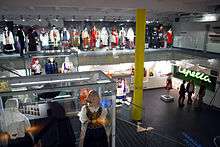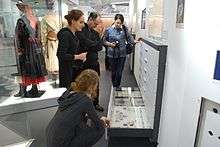National Museum of Ethnography
| Państwowe Muzeum Etnograficzne | |
.jpg) The neo-renaissance building of the museum designed by E. Marconi. | |
| Established | 1888 |
|---|---|
| Location | Warsaw |
| Type | ethnography |
| Director | Adam Czyżewski |
| Website | ethnomuseum.website.pl |
Państwowe Muzeum Etnograficzne w Warszawie is a museum of ethnography in Warsaw, Poland. It was established in 1888.
Collection and exhibitions
The collection is made up of objects, folk art, costumes, crafts, sculptures, paintings and other art from Poland, Europe, Africa, Australia, Oceania and Latin and South America.


The museum has a permanent exhibition, a library (around 26 000 volumes),[1] a Photographic and Film Records Studio and a Central Repository for the Museum's Collections; it produces temporary exhibitions, research projects and publications.
The Polish collection is composed of around 13500 exhibits in the permanent collection and over 1000 in the deposits.[2]
The African collection is the richest collection in the museum with over ten thousand objects mainly from Sub-Saharan Africa. The African collection is based on a donation by Wacław Korabiewicz which includes domestic and agricultural utensils, arms, costumes and clothing, jewelry, royal insignia, sculptures, masks and objects related to religious practices. In 1988 also Aleksandra and Cyprian Kosiński contributed to the museum's African collection with sculptures, masks and royal costumes of the Congolese tribes Bakuba, Bakongo, Chokwe. According to the museum,[3] one of the most important objects of the African collection are helmet masks made by the East African Makonde tribe (Tanzania, Mozambique) which came from Wacław Korabiewicz's collection.
The permanent exhibitions presented inside the museum are:
- The Flight. Asian Magical Weapons, curated by Jacek Szelegejd.
- Africa, curated by Jolanta Koziorowska.
- Australia and Oceania, curated by Robert Andrzej Dul.
- Polish Folk Art Gallery, curated by Jagoda Migdał.
- Folk Handicraft, curated by Małgorzata Jaszczołt.
- Polish Annual Rites, curated by Barbara Ogrodowska.
- The Ordinary – The Extraordinary. The Ethnographic Museum's Fascinating Collections. The Museum's 120th anniversary exhibition, curated Joanna Bartuszek, Anita Broda, Robert A. Dul, Rafał Gorczyca, Małgorzata Jaszczołt and Jolanta Koziorowska.
Departments
The museum is managed by a director and it is organized into the departments of Polish and European ethnography, non-European ethnography, adult education, educational, communication and marketing, publications, archival material and photographic and film records, accounting and finance, personnel, administrative and technical, inventory and conservation.
The museum has published its own magazine, "Zeszyty Muzealne", from the 1960s to the beginning of the 1980s; in October 2009 it started a new quarterly magazine called "Etnografia Nowa" ["The New Ethnography"].[4] In 2011 the museum received grants to renovate the building and create a children's ethnographic museum within its walls.[5]
Notes
- ↑ Description of the library on the museum website
- ↑ "Poland and Europe". Retrieved 2 October 2014.
- ↑ "Non European countries". Retrieved 2 October 2014.
- ↑ "About "The New Etnography"". Retrieved 2 October 2014.
- ↑ Project title "Increasing the accessibility of cultural infrastructure by modernizing the building of the State Ethnographic Museum in Warsaw", 2011.
External links
| Wikimedia Commons has media related to Ethnographic Museum in Warsaw. |
Coordinates: 52°14′17″N 21°0′44″E / 52.23806°N 21.01222°E